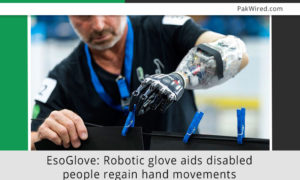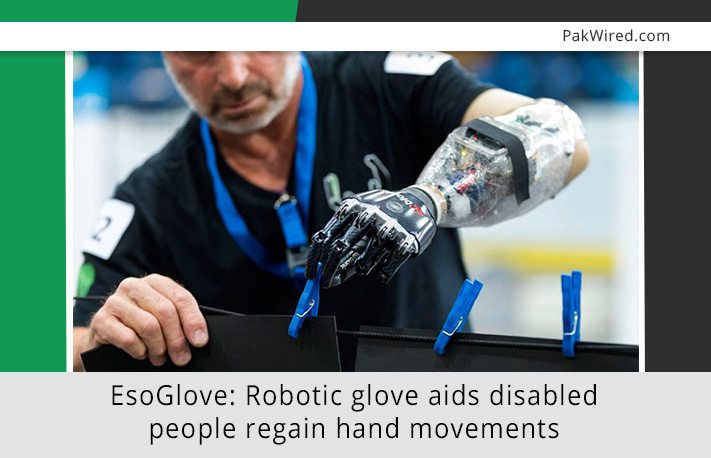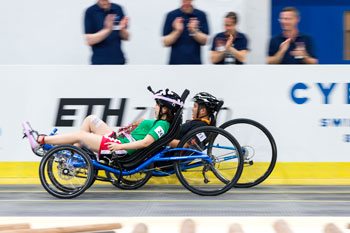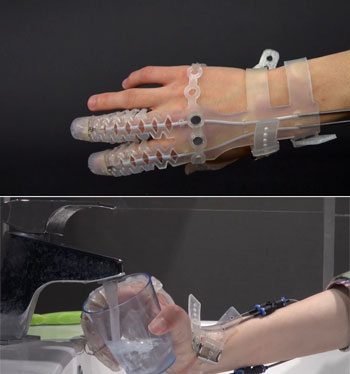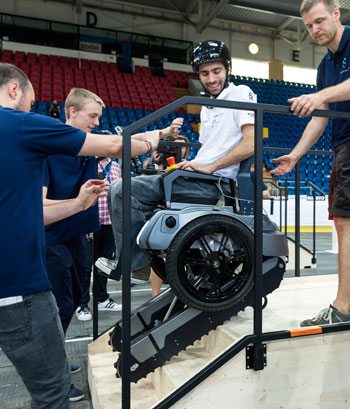Simple hand movements can turn out to be an ordeal for disabled people. A new rehabilitation device called EsoGlove has come in the limelight recently for its flexible functions and lightweight structure. This has given a ray of hope to people who have lost their hand movements due to major injuries or nerve-related conditions. The device is made up of soft materials with sensors to detect muscle signals and allows natural human movements to function properly. As a result, it reduces the risk of any further injury or inconvenience for the patient.
EsoGlove is a highly a compact and easy to carry device, which is a great benefit for recovering patients as they could carry out rehabilitation exercises anywhere conveniently.
A talented research team from National University of Singapore (NUS) has developed this device. The team includes Assistant Professor Yeow, his clinical collaborator Dr Lim Jeong Hoon (NUS Department of Medicine), PhD candidate Mr Yap Hong Kai and Mr Benjamin Ang Wee Keong (an undergraduate student), both from the NUD department of Biomedical Engineering.
Being an expert in soft wearable robotics, Professor Yeow stated:
“For patients to restore their hand functions, they need to go through rehabilitation programs that involve repetitive tasks such as gripping and releasing objects. These exercises are often labor intensive and are confined to clinical settings”
Moreover, he also added:
“EsoGlove is designed to enable patients to carry out rehabilitation exercises in various settings – in the hospital wards, rehabilitation centers and even at home. Equipped with technology that can detect and interpret muscle signals, EsoGlove can also assist patients in daily activities. For instance by guiding the fingers to perform tasks such as holding a cup”
Highly convenient and comfortable
This device is different from conventional robotic devices which comprise of very hard electromechanical components. Subsequently, it makes life highly uncomfortable for patients.
While highlighting its flexibility, Professor Yeow said:
“EsoGlove is unique as it is made entirely of soft components and does not require complicated mechanical setups. The main body of the glove is made of fabric, with soft actuators embedded. It also has adjustable Velcro straps to cater to different hand sizes”
It is attached to a pump- valve control system that moderates the air pressure that directs the soft actuators. When these actuators are pushed by air, a distributed force is applied along the entire finger to trigger its movements. These movements include bending, extending and twisting, to support different hand motions.
The entire beauty of this method is that it doesn’t refrain fingers to carry out natural movements as opposed to conventional devices. Each actuators works independently thus allowing every finger to move separately.
Furthermore, the usage of EsoGlove is widespread as it could be used for bedridden patients as well as waist-belt versions for patients who are at home.
Efficient control system
The robotic glove has a spontaneous control mechanism which combines electromyography and radio-frequency identification technologies. This function allows the device to gauge a patient’s intent to do a task such as holding a pen or gripping an object.
As opposed to the rigid movements of conventional robotic devices, EsoGlove aids patients to move their fingers intuitively.
Senior Consultant National University Hospital Division of Neurology, Dr. Lim stated:
“With this unique approach, we can develop therapeutic tools using safe and wearable robotic technology. Patients can take the initiative in their own rehabilitative process, rather than being passive recipients of therapists’ intervention”
Mr. Yap, from NUS Graduate School for Integrative Sciences and Engineering also added:
“As the soft actuators in the EsoGlove are made from non-ferromagnetic materials, they are suitable for use in functional magnetic resonance imaging studies. We hope that the robotic glove can contribute towards investigating the brain’s activity in relation to motor performance during hand rehabilitation, and unravel the functional effects of soft rehabilitation robotics on brain stimulation”
The commercialization of the device is on the cards as Mr. Yeow and his team plan to begin pilot clinical studies to validate its performance. Moreover, they will also take feedback from patients to further refine the design and its usability. However, this entire process is expected to take another six months involving 30 patients.
Article and Images Source: NUS, ScienceNews

